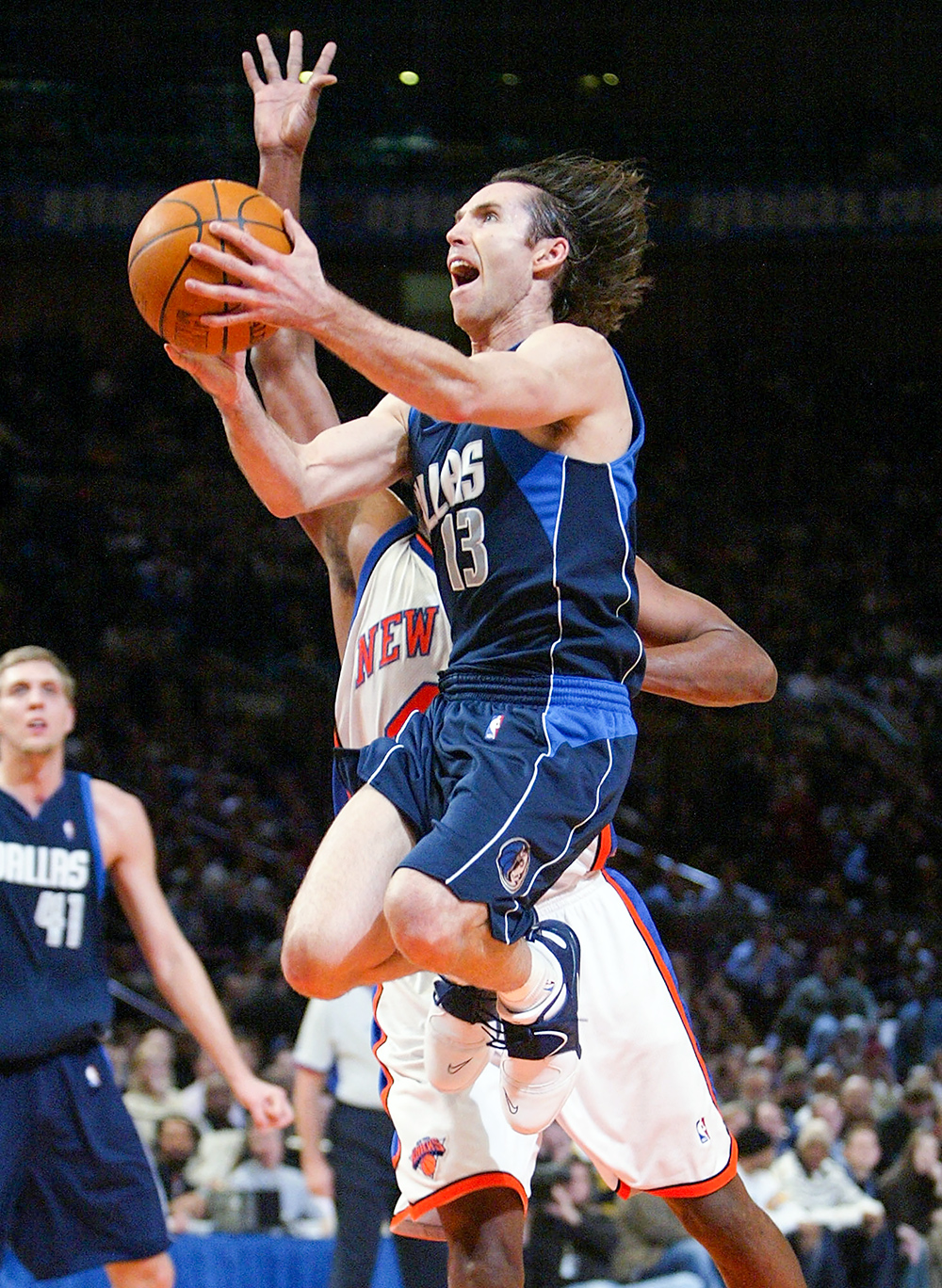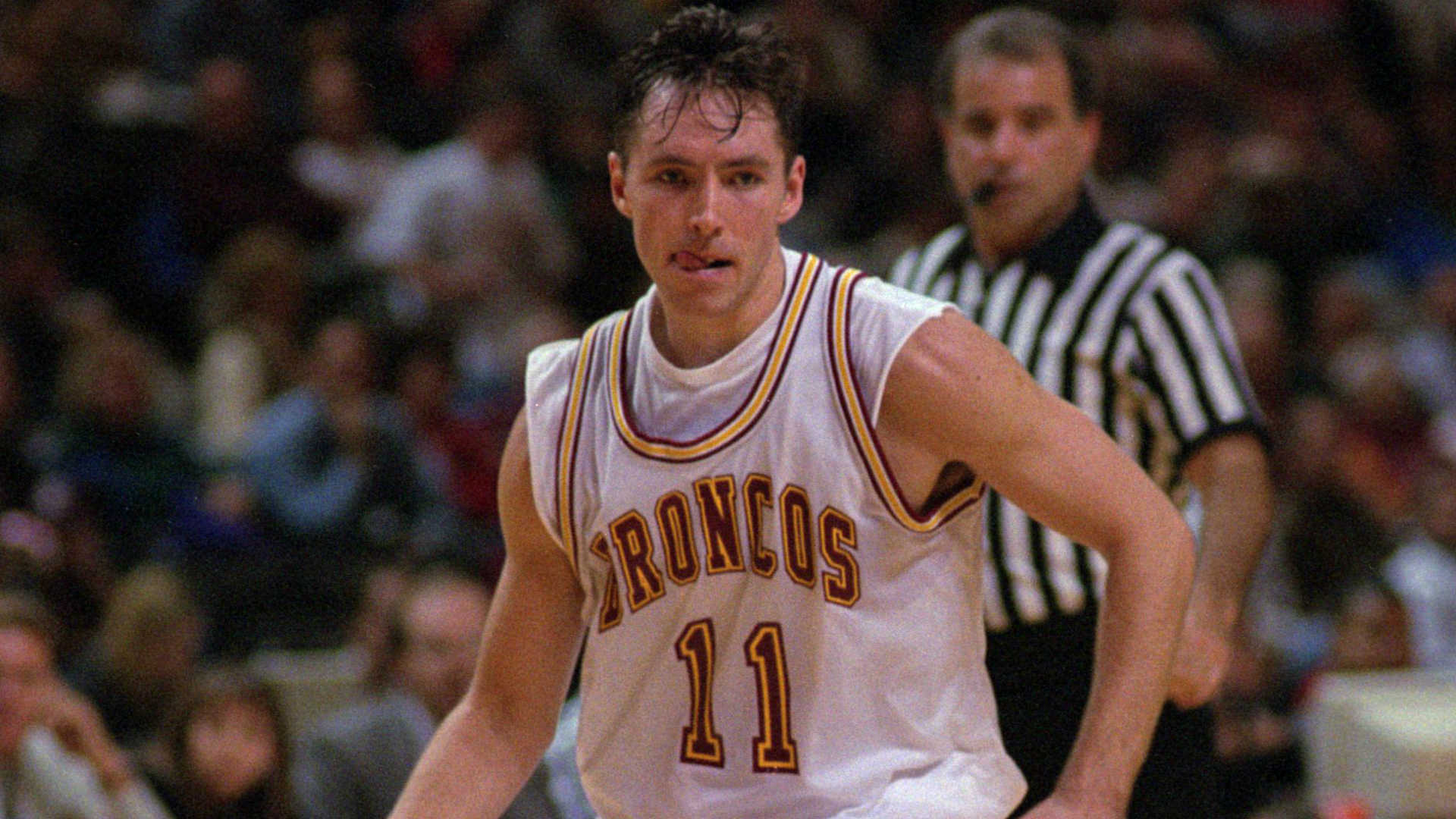The NBA celebrates NBA 75 roster players almost daily from now until the end of the season. Today’s honoree is Steve Nash, who was an All-Star with the high-scoring Mavericks in 2002. This story, by Sean Deveney, appeared in the February 11, 2002 issue of The Sporting News.
There is a scene in JD Salinger’s novel “The Catcher in the Rye” where Holden Caulfield is on a date with old girlfriend Sally Hayes. Sally tells her that she really should change her hair, because her current cut is “cheesy” and if she changed it, her hair would be, “so beautiful”.
Caulfield’s reaction: “Lovely my butt.” It’s no wonder, then, that Mavericks point guard Steve Nash considers Caulfield to be a soul mate. Few in the NBA have a hairstyle as well known as Nash, like a ball of frayed yarn that rests on their youthful face, sometimes pointing, like Medusa, in various directions, sometimes parted and neatly tucked behind the ears as if it were a pilgrim on the Mayflower. Ignore the advice to cut it, gel it, style it, or acknowledge its existence.
What most don’t understand is that Nash doesn’t really care about his hair. Maybe he would brush it off if it was something he thought about, but he doesn’t. It is a mistake to think that Nash has grown his hair as part of an image, that his unruly hair makes him appear more unruly. Even Mavericks owner Mark Cuban says, “It’s about Steve’s hair. He loves the fact that it gets so much feedback from people.” Nash’s reaction: Answer my butt.
“I don’t really care what people’s response is, that’s how my hair is,” he says. “I don’t take care of it, nor do I comb it, nor do I put anything on it, nor do I comb it or anything. When people comment on it, I find it funny that it gets so much attention. It makes me realize how insignificant that kind of thing is, how silly it is to get carried away with it. “
Such is Nash’s fish-out-of-water nature, making him an unlikely candidate for NBA stardom. In an image-conscious league, Nash doesn’t cultivate a personality. Let your hair just fall where it pleases. Avoid attention. After Canadian sports journalists nominated him as the nation’s male athlete of the year, he politely requested that his name be removed from consideration because he felt there were more deserving candidates. He enthusiastically read journalist Naomi Klein’s 1999 anti-globalization book, No Logo, which includes several chapters on one of the NBA’s best bedfellows, the logo-centric sneaker companies. According to his agent, Bill Duffy, the book influenced Nash, who turns down most sponsorship offers. “I can think of several important things that we have presented to him, but he is not interested,” says Duffy. “He has his principles, and we respect him. I talk to him a lot, but we don’t even talk about business. Steve is much more than that. He has perspective on everything he does.”
Although he is able to maintain his perspective on the world, Nash remains a tenacious and motivated basketball player. His ability to balance those aspects, while being laid-back and ambitious, has been vital to his success. Outside of the NBA limelight, Nash, who recently read “Catcher in the Rye” for the first time, might be a misfit for Caulfield, as he puts it, “Caulfield was an amazing character, and I think I see some similarities with myself. , but I think we can all relate to him. ” his career in points (19.5) and assists (7.9), and his stardom was confirmed by his selection to the Western Conference All-Star team last week, an honor he was sure he would eventually achieve.
“Once I realized that I could play in the NBA, I also thought I could be an All-Star,” says Nash. “I knew I could do it. And if it didn’t. I think that would be my misgivings, not anyone else’s. It would depend on my commitment to the challenge. Because I felt like it was something that I am capable of. With hard work and mental growth, I knew I could get there. “
Not long ago, such confidence on Nash’s part would have sounded delusional. Entering last season, the Mavericks competed for Nash, acquiring point guard Howard Eisley from the Jazz and giving Eisley a seven-year contract. That competition continued a trend in Nash’s professional career. In his first two seasons with the Suns, Nash was buried behind point guards Jason Kidd and Kevin Johnson and averaged just 16.7 minutes. He was traded to Dallas before the 1998-99 season shortened by the lockout and the Mavericks awarded him an applauded six-year, $ 33 million deal, which also made him co-captain. Keeping quiet about the ankle and back injuries, Nash played in pain and played terribly. He lost minutes to day laborers Erick Strickland and Robert Pack and shot just 36.3 percent in his first season in Dallas.
By the end of that season, Nash was a regular target of boos on the court. The Mavericks, touted as a potential playoff team by coach Don Nelson before the season, were a 19-31 mess, with Nash taking most of the blame. But he had no trouble keeping his perspective. During the worst of the boos, Nash remembers seeing his younger brother, Martin, in the stands, laughing. After seeing Martin’s reaction, Nash also started laughing to himself.
“It’s hard to take these things too seriously,” says Nash. “Seeing that made me realize that you have good games, you have bad games. You have good years, you have bad years. I’ve always been a bit philosophical about it, remembering it’s just a game. “
Doubt has also been a recurring theme for Nash. He has taken a strange path to the NBA, graduating from St. Michael’s College in British Columbia as an outstanding high school athlete and winner of Provincial Player of the Year honors in basketball and soccer. It was during his senior year at St. Michael’s that he decided to focus on the NBA, but he was struggling enough to get a college scholarship. He sent a low-quality video filmed by a friend’s father to American universities, but received no response. He was recruited by the Canadian schools Simon Fraser and Victoria, but knew that he would have to play in the United States to get to the NBA. Finally, he heard of a Division I school, Santa Clara
“The first thing we wanted was another video,” says Santa Clara coach Dick Davey. “The first one wasn’t of the best quality, and the players weren’t very good. I remember my assistant looking at him and laughing, and I asked him what was so funny. He said, ‘This video of a Canadian kid taking down defenders on.'”
Once in Santa Clara, Nash put together a legendary career that included three trips to the NCAA Tournament and first-round upsets in Arizona and Maryland.
But more than that, he developed the dual sides of his personality. He was, as Davey puts it, “quiet and very popular, a flute player on campus,” and even today his poster hangs in various Santa Clara coffee shops. At the same time, he sharpened his focus on the NBA. Despite how enjoyable he was at school, Davey says Nash was “deranged” when it came to his focus on basketball. Duffy, a Santa Clara alumnus, met Nash during his freshman year and told him he needed to work on his ball handling. Nash took to bounce a tennis ball wherever he went.
“We practice all day, then have dinner and come back with five partners to play 3v3,” says Davey. “It also made the other players go crazy.”
“I’ve been watching Steve Nash since he was in Santa Clara when I was at Golden State,” says Mavericks backup guard Tim Hardaway. “He’s a gym rat. One day, he’ll learn something and go out to practice, practice, practice.”
Deranged is a good description of Nash’s style. Thanks to the tennis ball, he is a skilled ball handler who likes to speed up the pace and can surround defenders like a water bug. As one scout puts it, “He sees the floor, the whole floor, as well as anyone, and he knows exactly where he can go. So he just does it.”
His ability – and preference – to distribute the ball has been a source of frustration for both Davey and Nelson. In Santa Clara, Nash passed the ball to his teammates and took just four or five shots in the first half, then took over games in the second half. His instinct is the same in the NBA. He wants to go first, an irritating trait for Nelson. The coach has insisted that Nash be more of a scorer.
“I’ve always loved the boy, but sometimes I had to get hard on him,” says Nelson. “He refused to do what I asked him to do. I needed to break from that. I needed him to get 18 points per game. He was happy to get 8 or 9, and we couldn’t win that way.”
Now, despite being an off-court freak, Nash is scoring more and running the league’s highest-scoring offense. After all, it fits quite well.
“He could always shoot,” says Hardaway. “He just never fired. That’s not a problem anymore. You don’t have to yell at him to do it. He’s the perfect point guard for this team.”


